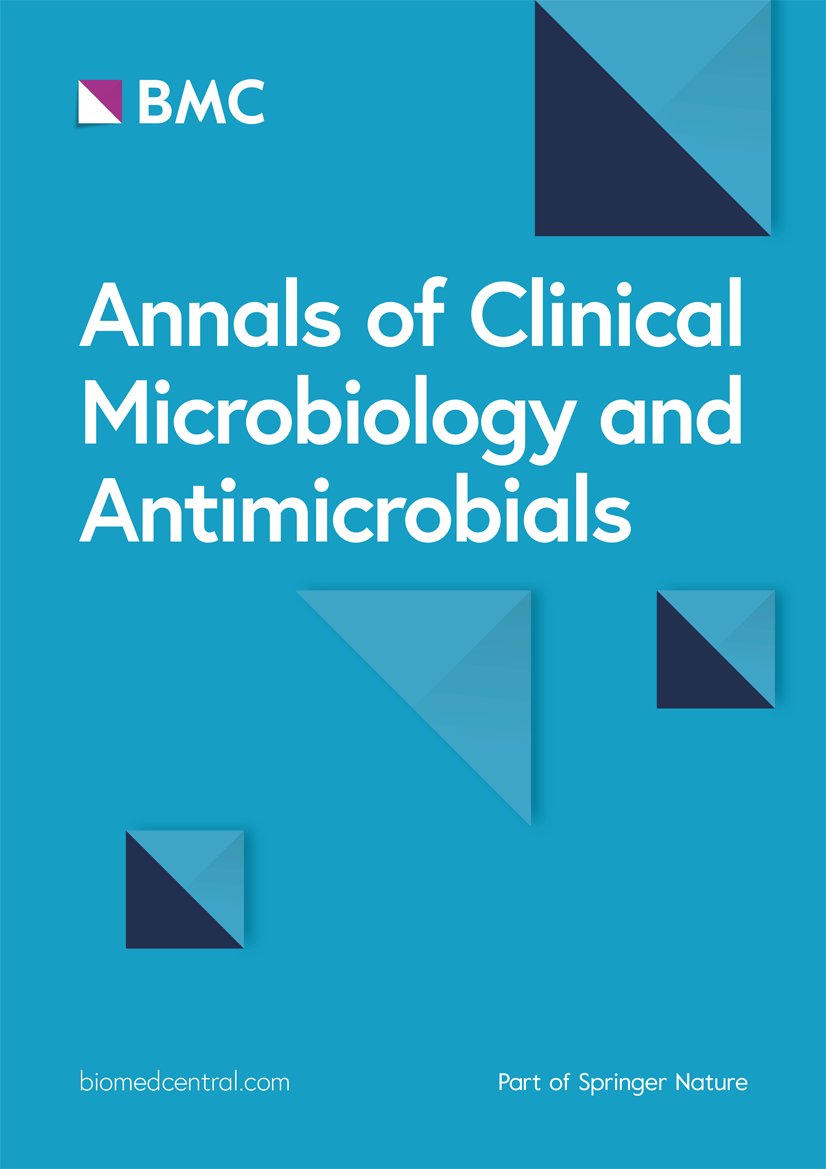对中国携带 blaOXA-48 和 blaNDM-1 的欧洲柠檬酸杆菌临床分离株进行全基因组测序
IF 4.6
2区 医学
Q1 MICROBIOLOGY
Annals of Clinical Microbiology and Antimicrobials
Pub Date : 2024-04-29
DOI:10.1186/s12941-024-00699-y
引用次数: 0
摘要
利用全基因组测序分析耐碳青霉烯类抗生素的欧洲柠檬酸杆菌的临床感染特征和耐药基因的遗传环境。使用 BD Phoenix™ M50 系统和 Kirby-Bauer (K-B) 磁盘扩散法评估了两株临床分离的欧洲柠檬酸杆菌(WF0003 和 WF1643)对 24 种抗菌药物的敏感性。在 Illumina 和 Nanopore 平台上进行了全基因组测序,并使用 ABRicate 软件预测了耐碳青霉烯菌的耐药性和毒力基因。分析了携带碳青霉烯类耐药基因的质粒的特征及其遗传环境。利用单核苷酸多态性构建了一棵系统发生树,分析了这两株欧鼠李菌株与NCBI数据库中10株欧鼠李菌株的同源性。这两株耐碳青霉烯类的欧洲杆菌对多种抗菌药,尤其是碳青霉烯类和β-内酰胺类药物具有耐药性。WF0003 携带的 blaNDM- 1 位于与 pNDM-HN380 质粒高度同源的 IncX3 质粒上。它与 Tn125 的不同之处在于上游 ISAba125 中插入了 IS5,下游 ISAba125 被 IS26 所取代。WF1643 在 IncL/M 质粒上的 Tn1999 转座子中携带 blaOXA- 48,只携带该单一抗药基因。这两株欧鼠李菌株与 NCBI 数据库中的 10 株欧鼠李菌株的同源性分析表明,这 12 株菌株可分为三个支系,其中 WF0003 和 WF1643 均属于 B 支系。据我们所知,这是首次在中国报道欧鼠中存在携带 blaNDM- 1 的 IncX3 质粒。携带碳青霉烯类耐药基因的欧洲鹅膏菌菌株与抗菌素耐药性的传播有关,因此应持续监测欧洲鹅膏菌中碳青霉烯类耐药基因的存在。本文章由计算机程序翻译,如有差异,请以英文原文为准。
Whole-genome sequencing of clinical isolates of Citrobacter Europaeus in China carrying blaOXA−48 and blaNDM−1
To analyze the clinical infection characteristics and genetic environments of resistance genes in carbapenem-resistant Citrobacter europaeus using whole-genome sequencing. The susceptibility of two clinical isolates of C. europaeus (WF0003 and WF1643) to 24 antimicrobial agents was assessed using the BD Phoenix™ M50 System and Kirby-Bauer (K-B) disk-diffusion method. Whole-genome sequencing was performed on the Illumina and Nanopore platforms, and ABRicate software was used to predict resistance and virulence genes of carbapenem-resistant C. europaeus. The characteristics of plasmids carrying carbapenem-resistance genes and their genetic environments were analyzed. Single nucleotide polymorphisms were used to construct a phylogenetic tree to analyze the homology of these two C. europaeus strains with ten strains of C. europaeus in the NCBI database. The two strains of carbapenem-resistant C. europaeus are resistant to various antimicrobial agents, particularly carbapenems and β-lactams. WF0003 carries blaNDM− 1, which is located on an IncX3 plasmid that has high homology to the pNDM-HN380 plasmid. blaNDM− 1 is located on a truncated Tn125. It differs from Tn125 by the insertion of IS5 in the upstream ISAba125 and the deletion of the downstream ISAba125, which is replaced by IS26. WF1643 carries blaOXA− 48 in a Tn1999 transposon on the IncL/M plasmid, carrying only that single drug resistance gene. Homology analysis of these two strains of C. europaeus with ten C. europaeus strains in the NCBI database revealed that the 12 strains can be classified into three clades, with both WF0003 and WF1643 in the B clade. To the best of our knowledge, this is the first study to report an IncX3 plasmid carrying blaNDM− 1 in C. europaeus in China. C. europaeus strains harboring carbapenem-resistance genes are concerning in relation to the spread of antimicrobial resistance, and the presence of carbapenem-resistance genes in C. europaeus should be continuously monitored.
求助全文
通过发布文献求助,成功后即可免费获取论文全文。
去求助
来源期刊

Annals of Clinical Microbiology and Antimicrobials
MICROBIOLOGY-
CiteScore
8.60
自引率
0.00%
发文量
49
审稿时长
>12 weeks
期刊介绍:
Annals of Clinical Microbiology and Antimicrobials considers good quality, novel and international research of more than regional relevance. Research must include epidemiological and/or clinical information about isolates, and the journal covers the clinical microbiology of bacteria, viruses and fungi, as well as antimicrobial treatment of infectious diseases.
Annals of Clinical Microbiology and Antimicrobials is an open access, peer-reviewed journal focusing on information concerning clinical microbiology, infectious diseases and antimicrobials. The management of infectious disease is dependent on correct diagnosis and appropriate antimicrobial treatment, and with this in mind, the journal aims to improve the communication between laboratory and clinical science in the field of clinical microbiology and antimicrobial treatment. Furthermore, the journal has no restrictions on space or access; this ensures that the journal can reach the widest possible audience.
 求助内容:
求助内容: 应助结果提醒方式:
应助结果提醒方式:


